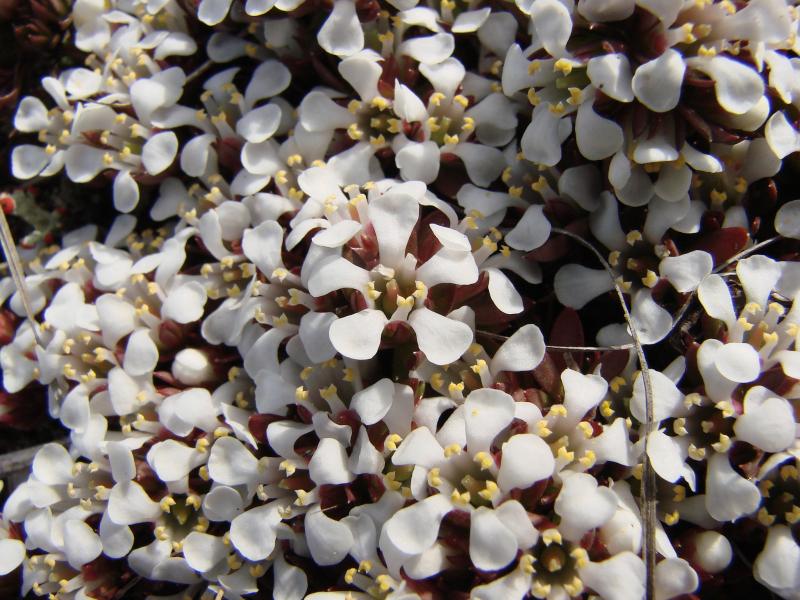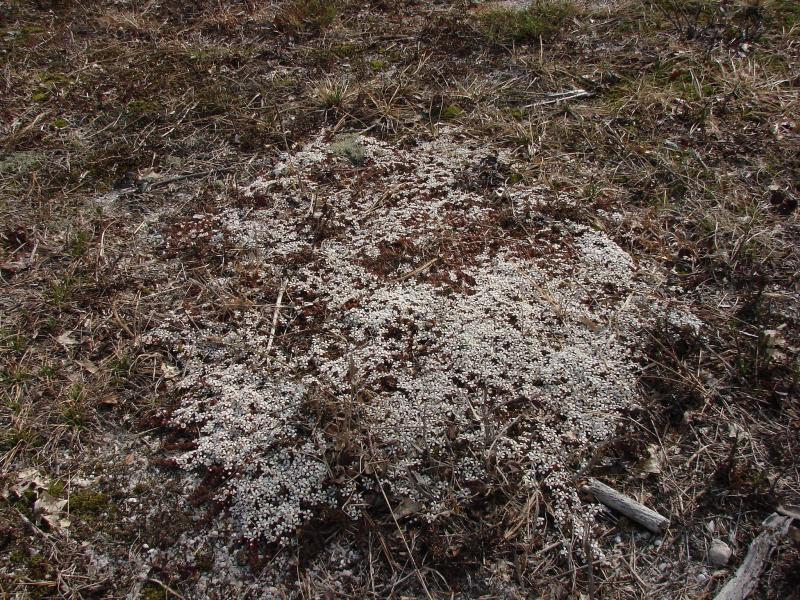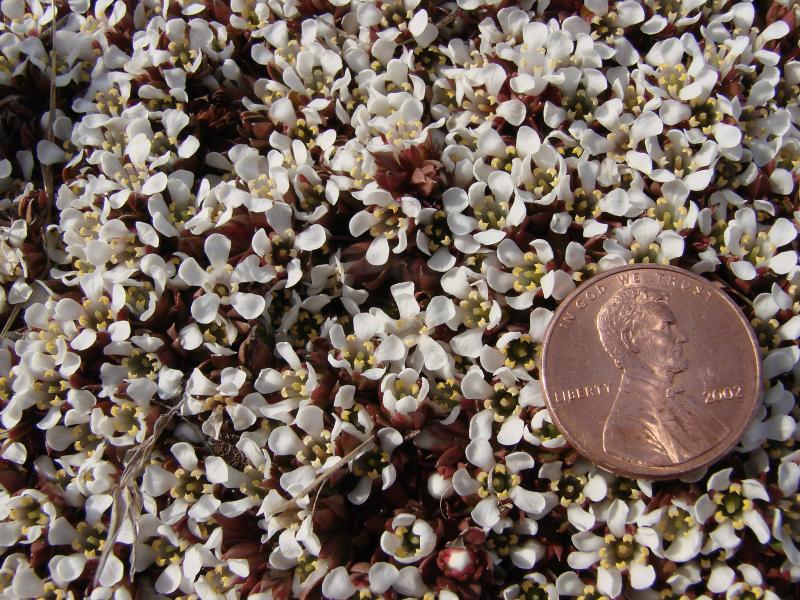Pyxies
Pyxidanthera barbulata Michx.
- Class
- Dicotyledoneae (Dicots)
- Family
- Diapensiaceae (Diapensia Family)
- State Protection
- Endangered
Listed as Endangered by New York State: in imminent danger of extirpation in New York. For animals, taking, importation, transportation, or possession is prohibited, except under license or permit. For plants, removal or damage without the consent of the landowner is prohibited.
- Federal Protection
- Not Listed
- State Conservation Status Rank
- S1
Critically Imperiled in New York - Especially vulnerable to disappearing from New York due to extreme rarity or other factors; typically 5 or fewer populations or locations in New York, very few individuals, very restricted range, very few remaining acres (or miles of stream), and/or very steep declines.
- Global Conservation Status Rank
- G4
Apparently Secure globally - Uncommon in the world but not rare; usually widespread, but may be rare in some parts of its range; possibly some cause for long-term concern due to declines or other factors.
Summary
Did you know?
The top of the anthers open like the lid of the box to release the pollen and this character gives the plant its genus name composed of the Greek pyxis, little box, and anthera, Latin for anther (Fernald 1950).
State Ranking Justification
There are two existing populations but one of them is very small. There are no other known historical populations.
Short-term Trends
The short-term trend is mixed because each of these populations fluctuates according to its different disturbance regime. One population has been reduced over time because of woody succession and the other has been increased because of favorable disturbance.
Long-term Trends
There have only ever been two populations known in New York. The long-term trend is uncertain due to the potential loss of one population to habitat succession.
Conservation and Management
Threats
Plants can be lost to succession and they may also be collected. One population was bulldozed and it was thought that it had been destroyed but it actually recovered and thrived because of the disturbance.
Conservation Strategies and Management Practices
One population needs more disturbance to remove shrubs that are encroaching upon and shading out the plants.
Research Needs
Research is needed to determine the best disturbance regime to maximize plant numbers.
Habitat
Habitat
The plants occur in sandy/gravelly disturbed openings in pitch pine oak woods. Sandy pine barrens (Gleason and Cronquist 1991).
Associated Ecological Communities
- Pitch pine-oak forest
(guide)
A mixed forest that typically occurs on well-drained, sandy soils of glacial outwash plains or moraines; it also occurs on thin, rocky soils of ridgetops. The dominant trees are pitch pine mixed with one or more of the following oaks: scarlet oak, white oak, red oak, or black oak.
Associated Species
- Andropogon glomeratus
- Baptisia tinctoria (wild-indigo)
- Drosera intermedia (spatulate-leaved sundew)
- Drosera rotundifolia (round-leaved sundew)
- Epigaea repens (trailing-arbutus, mayflower)
- Eupatorium hyssopifolium (hyssop-leaved thoroughwort)
- Eupatorium pilosum (ragged thoroughwort)
- Eurybia spectabilis (showy-aster)
- Euthamia caroliniana (slender flat-topped-goldenrod)
- Helianthemum canadense
- Hypericum canadense (lesser Canadian St. John's-wort)
- Juncus canadensis (Canada rush)
- Juncus dichotomus (forked rush)
- Lespedeza intermedia
- Liatris scariosa var. novae-angliae (New England blazing-star)
- Lycopodiella inundata (northern bog-clubmoss)
- Panicum virgatum (switch grass)
- Polygala lutea (orange milkwort)
- Rhynchospora capillacea (hair beak sedge)
- Schizachyrium scoparium
- Scirpus cyperinus (common wool-grass)
- Scleria triglomerata (whip nut sedge)
- Solidago elliotii
- Solidago nemoralis
- Solidago puberula (downy goldenrod)
- Tephrosia virginiana (goat's-rue)
Range
New York State Distribution
This small herb is only known from two localities in South Central Long Island.
Global Distribution
It grows on the Coastal Plain from Long Island south to southern New Jersey and from southeast Virginia south to northern South Carolina.
Identification Comments
General Description
Flowering pixiemoss forms low, up to 1 meter wide, round mats of tiny leaves. The clustered leaves are stiff, oblanceolate, 3-8 mm long with a sharp tip and are light green to reddish turning completely red late in the season. They are usually white-hairy towards the base. The mats produce masses of tiny, 5-petaled, white flowers that are 5-8 mm wide. The flowers are so numerous that, from a distance, the mounds resemble small patches of snow on the ground. The flat stamens stick out from between the bases of the petals and are topped by 2 yellow anther sacs. The small reddish brown capsules break open to release many seeds (Gleason and Cronquist 1991).
Best Life Stage for Proper Identification
The plants can be identified vegetatively but should be confirmed in flower or fruit.
Similar Species
There is no other plant that forms mats like this with masses of white flowers. From a distance mounds of hair-cap moss may resemble the mounds of pixiemoss but the leaves are much more narrow and there are no flowers.
Best Time to See
The best time to identify this plant is in early to mid April when its mass of flowers is easily visible.
- Vegetative
- Flowering
- Fruiting
The time of year you would expect to find Pyxies vegetative, flowering, and fruiting in New York.
Pyxies Images
Taxonomy
Pyxies
Pyxidanthera barbulata Michx.
- Kingdom Plantae
- Phylum Anthophyta
- Class Dicotyledoneae
(Dicots)
- Order Diapensiales
- Family Diapensiaceae (Diapensia Family)
- Order Diapensiales
- Class Dicotyledoneae
(Dicots)
- Phylum Anthophyta
Additional Common Names
- Flowering Moss
- Pixies
Additional Resources
Best Identification Reference
Gleason, Henry A. and A. Cronquist. 1991. Manual of Vascular Plants of Northeastern United States and Adjacent Canada. The New York Botanical Garden, Bronx, New York. 910 pp.
Other References
Clemants, Steven and Carol Gracie. 2006. Wildflowers in the Field and Forest. A Field Guide to the Northeastern United States. Oxford University Press, New York, NY. 445 pp.
Fernald, M. L. 1950. Gray's manual of botany. 8th edition. Corrected printing (1970). D. Van Nostrand Company, New York. 1632 pp.
Holmgren, Noel. 1998. The Illustrated Companion to Gleason and Cronquist's Manual. Illustrations of the Vascular Plants of Northeastern United States and Adjacent Canada. The New York Botanical Garden, Bronx, New York.
Mitchell, Richard S. and Charles J. Sheviak. 1981. Rare Plants of New York State. Bull No. 445. New York State Museum. Univ. of New York. State Ed. Department Albany, NY.
New York Natural Heritage Program. 2010. Biotics database. New York Natural Heritage Program. New York State Department of Environmental Conservation. Albany, NY.
New York Natural Heritage Program. 2024. New York Natural Heritage Program Databases. Albany, NY.
Newcomb, Lawrence. 1977. Newcomb's Wildflower Guide: An Ingenious New Key System for Quick, Positive Field Identification of the Wildflowers, Flowering Shrubs, and Vines of Northeastern and North-Central North America. Little, Brown and Company. Boston.
Weldy, T. and D. Werier. 2010. New York flora atlas. [S.M. Landry, K.N. Campbell, and L.D. Mabe (original application development), Florida Center for Community Design and Research http://www.fccdr.usf.edu/. University of South Florida http://www.usf.edu/]. New York Flora Association http://newyork.plantatlas.usf.edu/, Albany, New York
Links
About This Guide
This guide was authored by: Stephen M. Young
Information for this guide was last updated on: September 6, 2012
Please cite this page as:
New York Natural Heritage Program. 2024.
Online Conservation Guide for
Pyxidanthera barbulata.
Available from: https://guides.nynhp.org/pyxies/.
Accessed July 27, 2024.



